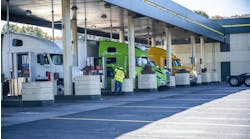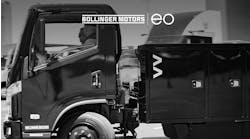That pioneering supplier of “shore power” systems to trucks at truck stops IdleAire Acquisition Co., LLC (formerly IdleAireTechnologies Corp.) shut down last month may have dampened enthusiasm for shore power as an idle-reduction solution. But idleAire’s demise by no means the end of efforts to make plug-in AC electrical power available to trucks. The Knoxville-based business, owned by six investment management companies, said it decided to cease operations when it couldn't find a buyer for its assets. (Read more in about green products in the Running Green section)
Out at truckstops, other, simpler shore power solutions are being installed that may make valuable contributions to conserving fuel, reducing emissions and restoring nighttime quiet to both truckstops and the neighborhoods around them. Back in August, for example, the nonprofit Cascade Sierra Solutions (CSS was awarded a $22.2-million grant from the Department of Energy (DOE) to advance truckstop electrification. CSS announced that it would partner with ShorePower Technologies to install Shorepower Truck Electrified Parking Space (STEPS) systems for diesel trucks at 50 truckstops in the U.S.
“Each of the fifty truck stops will get about twenty-five STEPS,” said Sándor Lau, development director for CSS. “Fleets need to know they will be available everywhere they go.” Unlike IdleAire’s entirely free-standing system, trucks do have to be equipped with onboard idle reduction systems and/or other devices that may be operated with AC electrical power to take advantage of the STEPS as a power source. CSS noted it will offer a rebate program for truck owners purchasing idle reduction equipment upgrades with electric standby capabilities.. Qualifying devices will be eligible for a rebate of up to 25% of the total cost.
“There was just no way that the IdleAire systems could be everywhere they were needed,” said physicist Dr. Linda Gaines, of Argonne National Laboratory’s Center for Transportation Research, Energy Systems Division. “But having a dual-capable system that allows drivers to plug in and avoid diesel fuel use if there's a handy AC source makes sense.”
“Once more trucks are more electrified, simple plug-in pedestals should be sufficient to augment any APU,” said Terry Levinson, senior project manager for Argonne National Laboratory. “Based on my experience with inventors and small technology businesses, sometimes being the first to the marketplace is not the best strategy. Sometimes the timing [and financing)]are not right. Sometimes the paradigm doesn't work -- yet.”
EnviroDock is another firm taking a different approach to shore power. They announced the grand opening of their first “E-Dock” stationary truckstop electrification site at the Canaan Truck Stop in Canaan, NY in July of 2008. The project was part of a cost-shared contract award from the New York State Energy Research and Development Authority (NYSERDA).
E-Dock Stationary is a stand-alone heating and cooling system enclosed in a cabinet, which can be mounted on 8-in. wheels to be moved to the vehicle or mounted on a concrete pedestal for permanent installations. The unit is designed to deliver filtered and temperate air to the truck cab via two thermally insulated flexible ducts inserted through a window control panel attached to a swinging arm. The window unit houses the control panel for temperature and fan speed, as well as a power outlet for in-cab appliances, such as computers and coffee makers.
“We try to offer the basics without making it too expensive or too complicated,” said Tom Greene, product manager for EnviroDock. “Our business model is also different than the IdleAire model. We just provide the units to truckstops, and then they own the units and collect the revenues. IdleAire used to maintain ownership of their units, including all the operating data. With EnviroDock, the truckstop operators have control over that, so that they can create their own reports, set pricing, document usage for carbon credits and so on.”
“There absolutely is a place for shore power today,” observed Lau. “As states continue to recognize that the cost to health [of vehicle emissions] is greater than the cost to remedy, we expect to see shore power installations increase.”



